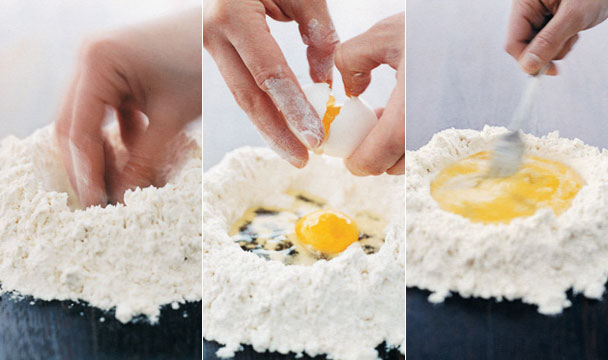Up until the last few years, my grandmother would routinely cook enough food every Sunday to quite literally feed our family of 10 all the way through Wednesday. This included producing twice-monthly batches of homemade tagliatelle with a meat ragù. She and I have made fresh pasta together several times, but given the speed, expertise, and preternatural strength of her hands, I always knew that to get comfortable with pasta dough, I would have to make it by myself—and probably practice many, many times.
So recently, armed with Lynn Rossetto Kaspar's recipe for fresh pasta that uses only flour and eggs, and an idea that I should resign myself to my maiden voyage being near-disastrous, I set to work. My first hurdle, as expected, was the “flour well”—a crater in the pile of flour that would contain the liquid eggs. “Contain” being a key word—in my every prior attempt, the walls of my well would always spring a leak, sending a gooey vein of egg running in an unauthorized direction. Sure enough, a wall soon crumbled and there went the egg; but this time, tipped off by Rossetto Kaspar, I was armed with a bench scraper—something I have never seen in my grandmother's house, but which allowed me to contain the leak with one hand while beating the egg with the flour, transforming it into a leak-proof dough, with the other. And I made the same mental note I always make but never seem to remember: Pile your flour low and wide, rather than tall and deep, and you'll be less likely have a border breach in the first place.
My next bit of kryptonite, I knew, would be the kneading. Unless you are male, a champion ping-pong player, or someone who kneads doughs by hand several times a week, you might lack the tricep strength required to work the dough for the 10 or 15 minutes required in many bread and pasta recipes. In these cases, you MUST pay attention to what your dough is doing, and perhaps tack on extra time. Sure enough, after the 10 minutes recommended by R.K., my dough was still shy of the “smooth, satiny, elastic” texture that I was looking for. In the past, I would have stopped anyway from sheer exhaustion, reasoning that I had put in my time; but now, I knew, I would only have been kidding myself. When you can't tell if your dough has reached a certain stage or not, it probably hasn't; keep kneading.
Finally, I moved on to rolling the dough, using one of my grandmother's ancient machines. First problem: My countertop and kitchen table were both too thick to clamp the contraption onto, and leaving it loose would have made it bounce around with each turn of the crank. I fastened it to a huge wooden cutting board, but when that didn't do the trick, I kept piling heavy things on top of the board—a cast-iron skillet, topped with a water-filled teapot. My husband walked in the kitchen at this point and found me sweating and cursing, the pasta machine et al. bumping around loudly on the counter as I rolled out the dough; he wisely left the room to wait for lunch. I couldn't help but feel the crush of failure as I draped my noodles over kitchen chairs, the first few strands clumping together (I had not yet remembered: Flour the dough lightly before every pass through the machine).
I tossed the noodles in the boiling water and warmed up the ragù I had cobbled together from lamb shanks that had been taking up space in the freezer. Well, I thought to myself as I stirred the pasta in the pot, you knew the first time wouldn't be perfect. But once I strained and dressed the noodles, I was shocked by the shape they were in. Golden yellow, with little bits of sauce clinging to them, they looked just right. We sprinkled on some cheese and dug in, and they tasted just right, too—the clumped noodles, for the most part, had even de-tangled in the hot water. A few bites in, I felt myself relax. “You know,” I said, “Making pasta is not actually that big a deal.” Michael agreed, politely overlooking the dusting of flour on the floor, the counter full of equipment and cast-off bits of dough, and the dried noodles stuck to my jeans. But I wasn't just being modest—knowing that I could mess up royally and still end up with a bowl of pasta more satisfying than money could buy was enough to erase the morning's angst.




 Pinterest
Pinterest


